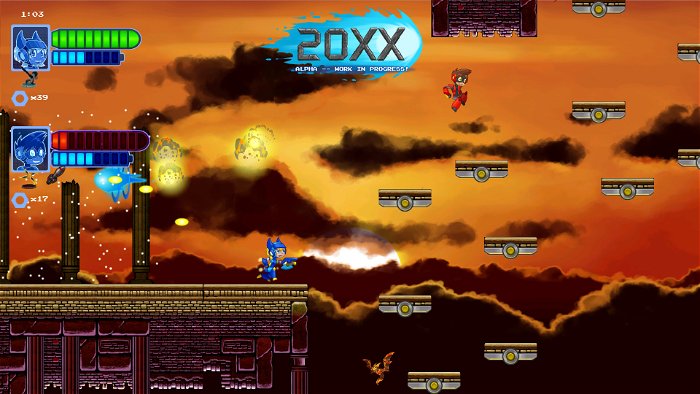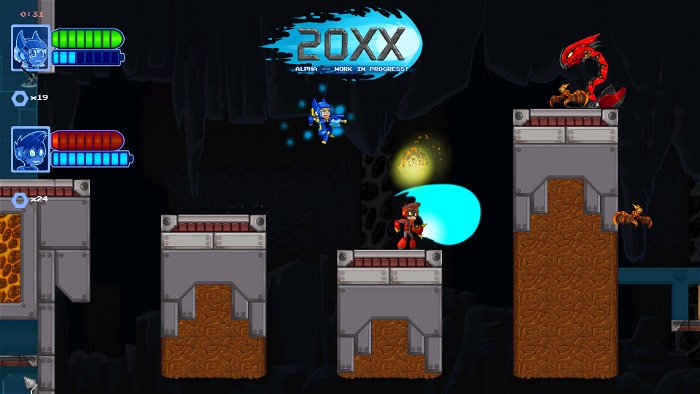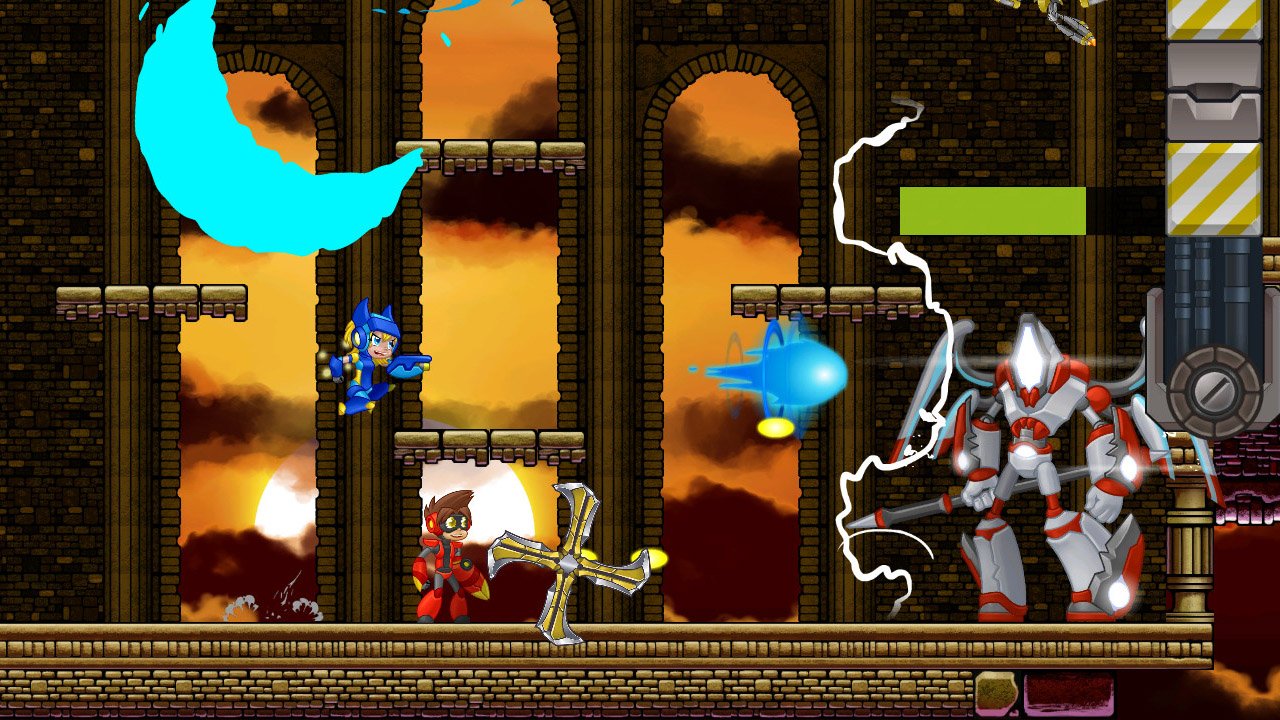Mega Man Rogue-like? Sure, okay.
One thing I love about rogue-likes – games with procedurally generated content designed to kill you and to make you consider resources and strategies in conjunction with repetition – is that you can take nearly every genre and make it fit the themes, and it works. Action games, adventure, RPGs, platformers – they pretty much work. I can’t think of a Mega Man style game that uses this format, but it’s definitely a good idea – platformers with challenging structure designed to make you think.

20XX is an early-access game, which of course means that it’s unfinished and not appropriate to properly review. It also means that there are a lot of flaws as a matter of course – bugs where enemies vanish for no reason, solid platforms with no substance, and a few graphical glitches. Overall, they’re not too bad, so it’s not something I plan to obsess over – the game shows off its basic structure quite well and the lacking polish mostly shows in how the Mega Man-style design works in random generation.
The plot’s thin right now, since it’s all revealed in journal entries, and only the female protagonist, Nina, has any entries you can recover. The plot’s very much a tribute to its roots, with robots taking over the world, mixed in with the kind of deconstructive silliness I’ve come to expect. The two characters we have now – the cheery-looking, gun-toting and far-too-cute Nina and the energy-blade-wielding Ace – are basically just X and Zero from Mega Man X. Again, they weren’t promising to be much else.
I played the game with mouse and keyboard, though the game recommends an Xbox controller. I’ve fought against purchasing another controller, working on ways to adapt my PS3 apparatus to allow me to play games. As that has proven insurmountable lately, I rely on only the keyboard, confident that playing under adverse conditions will give me a better view of the game.
I find the keyboard controls actually mostly fine. Jumps are consistent and precise under pressure after some practice, the characters are fairly responsive to your movements. Wall-jumping, however, has some issues when leaping between two nearby surfaces, due to a lack of response – it’s far easier to just jump up one surface than try and leap between two unless spikes are involved.

Levels are a collection of platform-jumping and enemy slaying. There are four separate levels, the first three being in random order, with difficulty of enemies and stage length increasing each time. The levels have a fairly stylish design, with a few different flourishes I like (dropping platforms in the jungle level, protective spheres in the ice-world’s sniper rooms). Enemies look like parody Mega Man villains, but their tactics and placements are deliberately designed to present challenges – swarms of fliers meet you as a shield-bearing foe reflects your shots, all while exploding kamikaze units detonate around you. It can be hectic, and it can cause you pain as you wear down. Bosses are randomized between two or three choices per level type, and often are just bigger versions of normal enemies. Some are quite simple to predict and decimate, some go down instantly with the right special powers, and some are just devastating to your health. It’s mostly as it should be. I personally find the ice level to be more challenging than the other two, due to the slippery floors and unique enemies (which are just designed to mess with your movements and test your patience).
Overall, it succeeds in making each level a challenge in choice. Money can be used for random health kiosks or the rare shops that give you more upgrades, and secret rooms can be found to give you more precious stat-boosting items. Even normal crates can drop the best items on occasion, making each one a decision as to whether potentially losing health for items you don’t need is worth the risk. The level’s bonus timers mean you want to rush to the end to get an extra upgrade crate, risking missing potential other items. Being stronger for the ridiculous final level is terribly important.
Overall, though, I notice a few of the standard rogue-like issues setting in. The sections of the map are based on templates, which eventually repeat themselves, with some enemy variation. Further, many of these rooms have large sections that can be skipped easily, particularly with wall-jumping – I could avoid most platforms by finding a sheer surface and just leaping up it. While each ‘section’ has obvious multiple paths to cross it and bypassing is an intended tactic, it does seem like it’s somewhat too easy to no-sell some areas. The repetition gets on you, given the flash-like graphics – the music is deliciously appropriate and I rather enjoy it, so it never quite gets tedious and keeps things bearable.
Honestly, I’m somewhat likely to forgive many things, particularly to an alpha game. However, this game definitely needs expansion – more section templates, more item variety (there’s only a few items I almost never see because they’re exclusive to one area, like the shops), and possibly a few more stage themes so it’s not always the same three before the last. The Binding of Isaac‘s enduring quality comes from the truly massive number of room/enemy combinations, and I hope to see more of that in this game. However, I praise them for the good insight to take a style that lends itself so well to the rogue-like genre.




